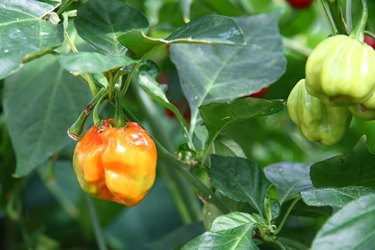
Peppers (Capsicum annuum) are a popular option for vegetable gardens, but you might find yourself wondering how to stop bugs from eating pepper plants if you add them to your garden. Aphids, Colorado potato beetles, flea beetles and tomato hornworms are common pests for pepper plants. Whether you grow peppers in containers or in the ground, take precautions when planting and watch for signs of pests to protect your pepper crop.
Choose the Planting Location
Video of the Day
Rotating your crops regularly helps prevent pests and pathogens from building up in the soil. If you always plant your peppers in the same location, the pests might be waiting to attack the following year.
Video of the Day
It's best to plant your peppers away from certain other vegetables that might attract potential pests. Keep your peppers away from nightshade plants, as they can attract pepper weevils and tomato hornworms. Onions, garlic and cereal grains often attract thrips, so it's best to avoid planting peppers near them.
Some companion plants can help repel insects that might otherwise find your pepper plants. Strong-scented plants, such as basil and rosemary, can help repel aphids. Planting dill, basil and marigolds near your peppers can help protect them from tomato hornworms.
Use Row Covers
Row covers in the early stages of growth can help protect your young pepper plants from pests, such as Colorado potato beetles and flea beetles. The physical barrier can keep the pests away from the plants if you put on the row covers before the pests arrive. Row covers can also help protect your pepper plants from colder temperatures early in the growing season.
Apply a Layer of Mulch
Reflective mulch can help deter some pests, including thrips and aphids. Silver-colored plastic is an example of a reflective mulch option. Straw mulch can help if Colorado potato beetles are an issue in your area. The mulch also helps regulate the soil temperature, control weeds and retain moisture. All of these benefits help your pepper plants grow better. A strong, healthy plant is better able to fight off pests and diseases on its own.
Weed Your Garden
Weeds can attract various pests and serve as cover for them. Keep your vegetable garden clean by weeding it regularly. Pay special attention to the area around your pepper plants. Remove the weeds and any other plant debris from the garden area immediately to keep pest populations under control.
Pick Bugs From Pepper Plants
Large pests that you can see can be picked off the plants and destroyed. For smaller pests, such as spider mites and aphids, spraying the plant with water from your garden hose can wash away the bugs. You can also prune parts of the plant that are infested with large amounts of insects, such as aphid clusters. Destroy the removed sections to prevent the pests from infesting the plant again. Check the plants frequently to spot and remove the pests in case they return or you miss some.
Apply Safe Treatments
Avoid synthetic chemical pesticides for your pepper plants since you're consuming the fruits they grow. Synthetic chemicals can be harmful to you, your pets and the environment. They also kill the beneficial insects in your garden that help keep the pests under control, which means you lose that natural defense. Unless the infestation is major and you can't control it using other methods, you don't usually need insecticides for your peppers.
If you feel that you need a treatment option, insecticidal soap is one option that's safe for use on vegetables. It's a less-toxic option, and many beneficial insects are safe from these types of sprays. Insecticidal soap works best on thrips, aphids, spider mites and other soft-bodied insects.
Follow the instructions precisely for mixing the insecticidal soap, or purchase a ready-to-use product in a handy spray bottle. Apply the soap on a day that's overcast and 90 degrees Fahrenheit or below. Spray it on all surfaces that are affected by the pests, including the underside of leaves. Reapply once or twice per week based on the package instructions.